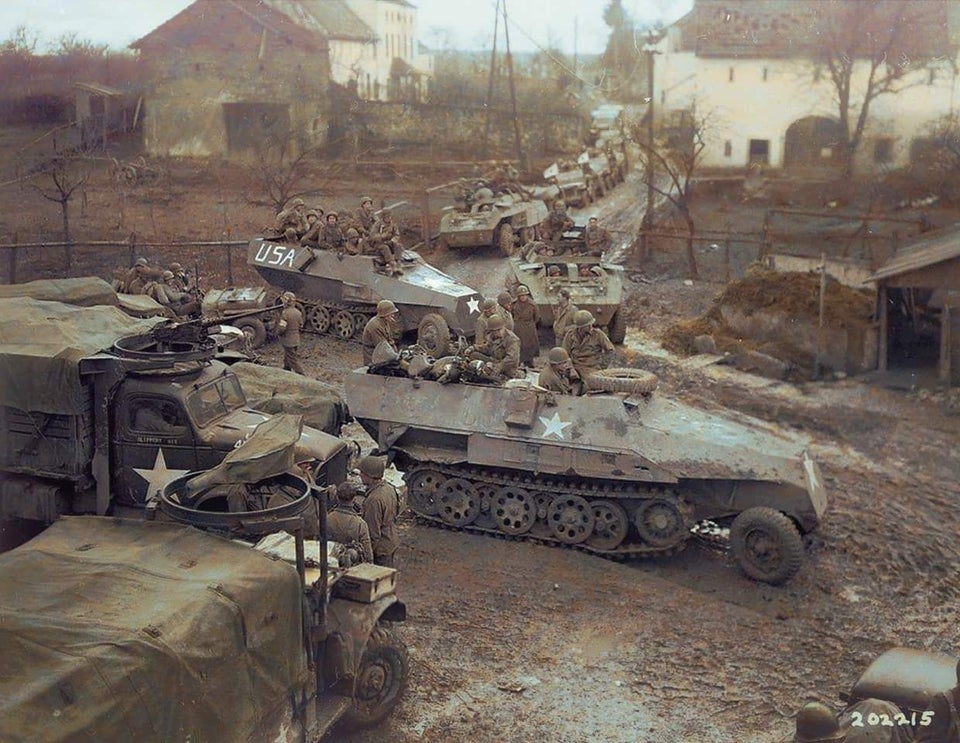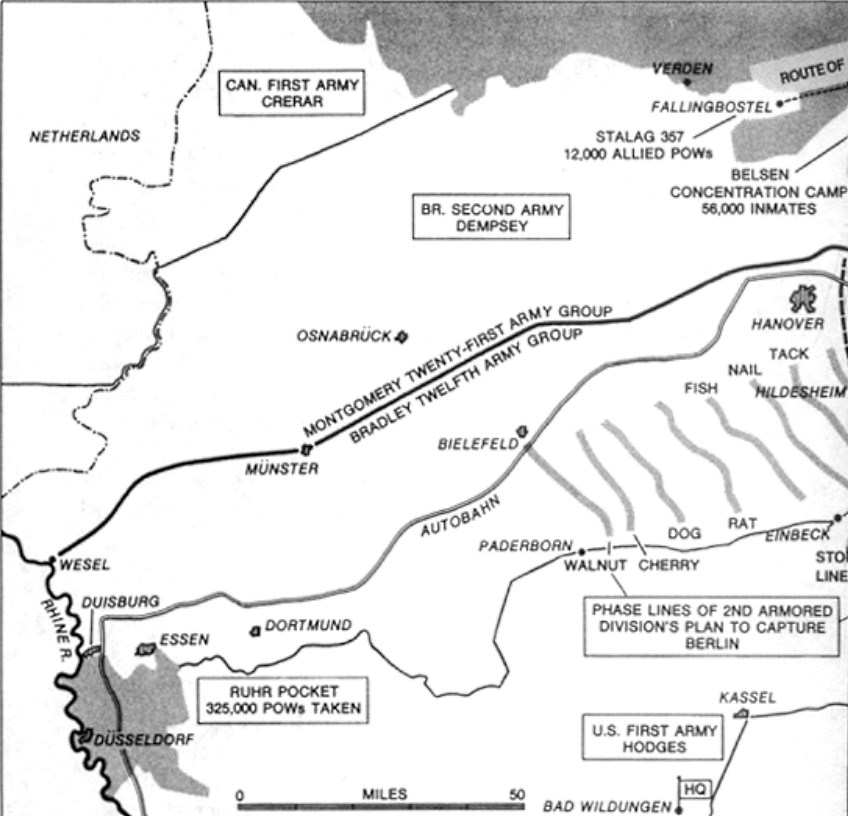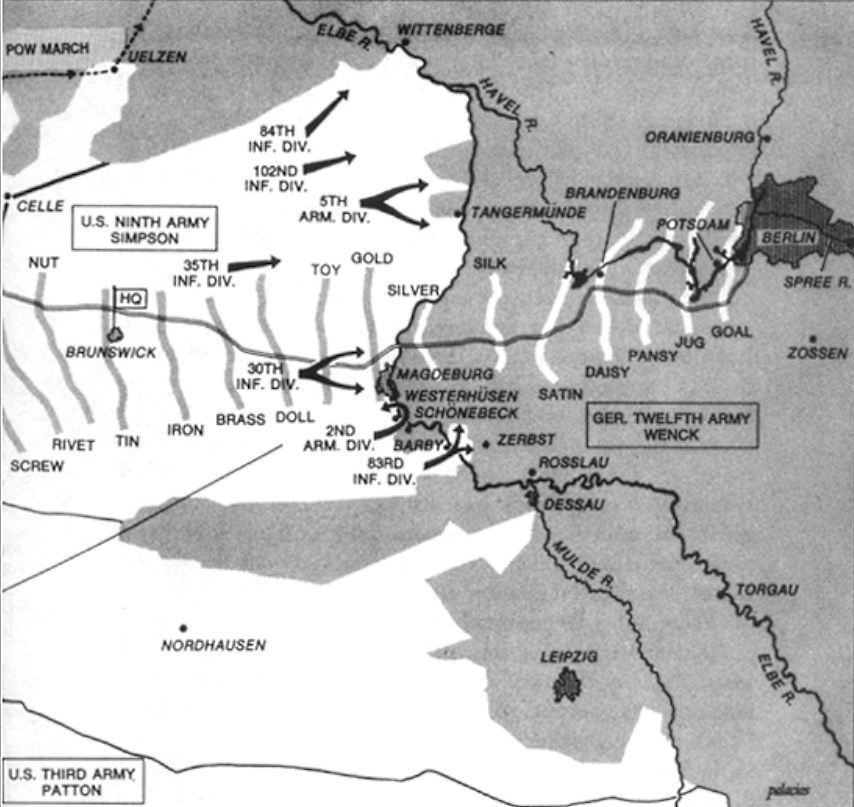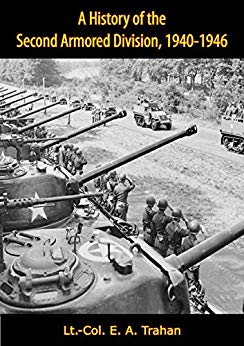
Members of the American 83rd Infantry Division used all sort of captured German vehicles in their race to the Elbe River.


It is April 12, 1945. The defeat of Hitler’s Third Reich is
assured. The Soviet army is barely 30 miles from Berlin, the British have
surrounded a German army group in the Netherlands, and the Americans have
encircled another in the Ruhr valley. Spearheads of Lt. Gen. George S. Patton’s
Third Army have crossed the border of Czechoslovakia. The U.S. Ninth Army,
under Lt. Gen. William H. Simpson, has achieved a bridgehead across the Elbe
River, just 50 miles from Berlin and an obvious springboard if the western
Allies wish to capture the city.
This is not an option that Gen. Dwight D. Eisenhower,
supreme commander of the Allied Expeditionary Forces, wishes to pursue. In his
view, Berlin has been so devastated by Allied bombing that its military value
is nil. Stalin, in a late March exchange with Ike, agrees (disingenuously, as
history shows), and Eisenhower tells him he has no plans to advance to Berlin.
Ike is more concerned with seizing the Bavarian Alps in
southern Germany, the location of Hitler’s famed Berchtesgaden retreat and the
reputed site of the National Redoubt, a gigantic Alamo from which the Nazis
might continue to resist indefinitely.
From a political standpoint the capture of Berlin seems
equally pointless. Postwar occupation lines have already been established.
Germany will be divided into four zones held by the Soviets, Americans,
British, and French, as will its capital. Taking Berlin might cost up to
100,000 casualties, notes Gen. Omar Bradley: “a pretty stiff price to pay for a
prestige objective, especially when we’ll have to fall back and let the other
fellow take over.”
Some Allied commanders disagree, notably Patton, Simpson,
and British Field Marshal Bernard Montgomery. But neither the Combined Chiefs
of Staff nor Roosevelt will second-guess Eisenhower. Churchill, however, favors
grabbing as much of Germany as possible, including Berlin—to use as a
bargaining chip to ensure that Stalin complies with the agreements he has made.
Churchill does not trust Stalin. Roosevelt seemingly does,
but on April 12 he dies of a massive stroke. Vice president Harry S. Truman, a
man in whom FDR rarely confided, takes the oath as president. Understandably,
he relies on the counsel of his military advisers. Although Churchill leans
heavily upon his British chiefs of staff, they cannot persuade their American
counterparts that Berlin should be captured.
Then Eisenhower reverses himself and orders a drive on
Berlin. He does so because rumors of the National Redoubt have been debunked by
Allied intelligence reports, rendering a thrust into Bavaria pointless.
American forces therefore need a new objective. Also, Truman’s accession to the
presidency converts Eisenhower to Churchill’s idea that holding German
territory east of the Elbe would buttress their negotiating power with the
Soviets.
The change of plan has risks. It may antagonize the Soviets
politically, and it carries the chance that the Allied and Soviet forces will
mistakenly clash, con verting political distrust into military dis aster. But
Ike assures Stalin that he wants to assist in what will be a bloody struggle
for the heart of Nazi Germany. This assurance finds a receptive audience among
Stalin’s top commanders, who are willing but not eager to fight their way into
Berlin, and surprisingly from Stalin himself, whose reasoning parallels
Bradley’s: If the Americans want to pay much of the price for a prestige
objective they must then relinquish, he will not object.
Supported by the First Army, Simpson’s Ninth Army lunges
toward Berlin. Resistance is heavy but not extreme. Continuing the pattern of
recent months, German troops prefer to surrender to the western Allies rather
than the Soviets. Indeed, some within the Nazi government entertain the fantasy
that the Allies are rushing to aid them in their struggle to save western
civilization from the Bolshevik hordes. Even so, it comes as a surprise when
two American airborne divisions and one British airborne brigade parachute into
Berlin’s Tempelhof Airport, less than three miles from the Reich Chancellery,
and quickly establish a defensive perimeter. Then a stream of C-47s land at the
airport, disgorge supplies and reinforcements, execute 180-degree turns, and
depart.
There is no need for the paratroopers to advance. Hitler,
enraged, orders attack upon attack against their enclave, removing units from
the path of the Ninth Army in order to do so. But the para troopers, shielded
by an umbrella of fighter-bombers as well as B-17s from the Eighth Air Force,
have scant trouble holding their position. The Soviet army now attacks, but
Hitler orders a bitter, block by-block resistance. The Ninth Army breaches the
western suburbs of Berlin, and three armored divisions, under Maj. Gen. J.
Lawton Collins, fight their way to the Reichstag. Hitler commits suicide in a
bunker beneath the Chancellery, and the surviving Nazi leaders surrender.
The above scenario is only one of several that could have
ensued had Eisenhower issued an order to drive on Berlin. Stalin might well not
have acquiesced to such an operation. The Soviets, who historically launched
their final offensive on April 16, could have done so even sooner. Ike’s fears
of a clash between Allied and Soviet forces might have been realized. The Ninth
Army might not have reached the outskirts of Berlin, much less the Reichstag,
ahead of the Soviets—though the U.S. Army’s post war official history estimates
that the Ninth Army could have gotten at least as far as Potsdam, a western
suburb of Berlin.
But the most seemingly fantastic element in the scenario, an
American airdrop on Berlin, is actually strongly plausible. Such a plan existed
as part of Operation Eclipse, the plan for the occupation of Germany, and, in
the event of an American overland drive on Berlin, would likely have been
carried out. Airborne commander James M. Gavin describes it in detail in his
1979 memoir On to Berlin. The airdrop was carefully practiced and a scheme
devised for the C-47s to land and discharge cargo in the manner described above.
Supplies piled up so rapidly that it became obvious that the critical problem
would be the removal of cargo from the field, not the act of flying it in.
Ike insisted in Crusade in Europe, his 1948 memoir, that he
acted correctly in eschewing Berlin, but he opined in 1952 and again in 1958
that the decision was a mistake. Signs of a breakdown in the Soviet alliance
were already apparent at that point in the war, and the advantages of the
political leverage Churchill desired over the Russians became evident when
Stalin failed to honor certain agreements made during the Yalta and Potsdam
conferences, such as his promise to hold a free election in Poland. As for
Gavin, immersed in the complexities of Berlin for years after the war, the
failure to take the German capital was a lifelong source of regret. “I have
never been able to satisfy myself as to why we did not seize it,” he wrote in
1979. “Now I know that we should have seized it.”
Originally published in the November 2009 issue of World War
II.
By Mark Grimsley
The Western Allies, after crossing the Rhine, spread out
across Germany. The Canadian 1st Army moved into the Netherlands. The British
1st Army advanced across Northern Germany towards the Baltic Sea. Patton’s
Third Army drove eastward towards Czechoslovakia. Courtney Hodges’ 1st Army
drove on Saxony, between Berlin and Bohemia.
The army that expected to be directed to Berlin was the
United States 9th Army, commanded by Lieutenant General William Hood Simpson,
part of the American 12th Army Group, under General Omar Bradley.

A History of the Second Armored Division, 1940-1946 by Lt.-Col. E. A. Trahan (Author)
The American 2nd Armored Division and the 83rd Infantry
Division took the lead, driving for the Elbe River. One spearhead of the 2nd
Armored drove 73 miles in a single day. They seized a bridgehead over the Elbe
in the suburbs of Magdeburg on April 12th. The 83rd Infantry Division reached
the river the next day.
With more American divisions coming up to support the 2nd
and 83rd, Simpson and his commanders expected to reach Berlin in a few days.
There were vigorous local German attacks on some of their bridgeheads, but most
of the German forces allocated to their front had been trapped in the Ruhr Pocket
two weeks earlier. The bulk of the German forces defending Berlin were lined up
along the Oder River, facing the Soviet Armies.
While Omar Bradley, at this point, estimated it would cost
the Americans a hundred thousand casualties to take Berlin, he was assuming an
organized defense. As of April 13th, 9th Army units were over the Elbe and 60
miles from the outskirts of the German capital. They had advanced some 150
miles the previous four days. Opposition was scattered, at best. The Soviet
armies were not scheduled to begin their Berlin offensive until the 16th. An
American drive from the Elbe to Berlin, even if they didn’t attempt to
penetrate into the city proper, might have unhinged German communications and
the entire German defensive plan for Berlin.
The historical Battle of Berlin would last two weeks and
cost the Soviets seventy-five thousand dead and three hundred thousand wounded.
It took the Soviets a week to cut Berlin off from the rest of Germany. At this
point, the 9th Army had been holding their positions along the Elbe for eleven
days, almost close enough to hear the sounds of the horrific battle in the
distance.
Ultimately, the Americans did not go to Berlin because the
realities of the Western-Soviet alliance forbade it. The U.S.S.R. had been a
pariah state in 1939, paranoid, oppressive, alienated from Western society. The
Soviets supported Nazi Germany faithfully with oil, food, and metals through
the first year and a half of the U-boat war, through the Fall of France,
through the Battle of Britain and the Blitz, while Britain had been fighting
for its survival over the winter of 1940 and 1941. When Germany betrayed his
alliance with Stalin in June of 1941, Stalin demanded help from the west. He
got it, but the Soviets continued to treat their American and British allies as
potentially hostile all through the war, even while accepting billions of
dollars worth of equipment and material in Western aid to support their war
effort.
As the armies drew closer together in April of 1945, Soviet
paranoia grew worse. The Soviet high command repeatedly delayed attempts to
establish liaison procedures to prevent American and British aircraft from
bombing Soviet troops by accident. Allied aircrew who were shot down or crashed
behind Soviet lines were treated virtually as prisoners of war. Few Soviet
observers joined the Allied armies. Their primary concern was making sure no
Germans surrendered to the Westerners while others in the same commands
continued to fight the Soviets.
The question never asked on this topic is, could an American
advance to Berlin have shortened the war and saved lives? It seems likely. If
the Americans had been given the order to advance, how would the Germans have
defended Berlin from the west? What effect would the American presence in
Potsdam have had on the Germans fighting the Soviets? And would Stalin have
ordered Zhukov to stage “incidents” to warn the Americans off?
#
This question can be answered in two different ways. First
is to focus on the military disposition of forces and fighting abilities. If
the Allies were willing to accept the increased casualties and losses, required
to accelerate their military campaign in a race to Berlin, yes they certainly
could have won the race to Berlin. Cited below, by 11 April the US was within
50 miles of Berlin.¹
It wasn’t until almost two weeks later that the USSR entered
Berlin.² Even though Stalin was willing to sacrifice men and equipment to
conquer as much of German territory as he possible could, despite the enormous
cost.³ In fact Stalin was goading his generals into competing to be the first
to enter Berlin. I would rather have been a soldier under Eisenhower, as
opposed to Hitler and Stalin. Both of these leaders had little regard for the
lives of their soldiers and often sacrificed them purely for political or
personal reasons (read vain and stupid reasons).
So the Allies were well within striking distance of Berlin
(without sacrificing men and equipment carelessly), so if it had been a true
‘race’ (with the lines of political control not already decided upon in advance
in the Potsdam Agreement³) the outcome might have been very different for
postwar Germany.
Even as it was, numerous German forces fought their way
through Soviet forces in order enable their comrades (and civilians) to
surrender to Allied Forces on the Elbe. The German population had already felt
the scourge of Soviet revenge for Nazi atrocities. So in a full on ‘race’ to
Berlin, that knowledge of impending Soviet treatment, and thus the desire to
surrender to the Allies, may have played definitively into the final geographic
outcome.
The Allied advance might have been massively impeded by huge
columns of refugees and dysfunctional German military units streaming west in
their desire to avoid the Soviets, and thus blocking the allied advance – sheer
logistics!
So yes, if the Allies had been willing to prosecute the war
to achieve the fullest expanse of conquered German territory, they could have
captured Berlin, and ‘met’ the USSR much further east. re JHS
¹“The Elbe River was the official Allied eastward objective,
but many American commanders still eyed Berlin. By the evening of 11 April,
elements of the 9th Army’s 2nd Armored Division—seemingly intent on
demonstrating how easily their army could take that coveted prize—had dashed 73
mi (117 km) to reach the Elbe southeast of Magdeburg, just 50 mi (80 km) short
of the German capital. On 12 April, additional 9th Army elements attained the
Elbe and by the next day were on the opposite bank hopefully awaiting
permission to drive on to Berlin. But two days later, on 15 April, they had to
abandon these hopes. Eisenhower sent Bradley his final word on the matter: the 9th
Army was to stay put—there would be no effort to take Berlin. Simpson
subsequently turned his troops’ attention to mopping up pockets of local
resistance.
²Within the next day, 25 April 1945, the Soviet investment
of Berlin was consolidated, with leading Soviet units probing and penetrating
the S-Bahn defensive ring.
³ The Soviet offensive into central Germany, what later
became East Germany, had two objectives. Stalin did not believe the Western
Allies would hand over territory occupied by them in the post-war Soviet zone,
so he began the offensive on a broad front and moved rapidly to meet the
Western Allies as far west as possible. But the overriding objective was to
capture Berlin. The two goals were complementary because possession of the zone
could not be won quickly unless Berlin were taken. Another consideration was
that Berlin itself held useful post-war strategic assets, including Adolf
Hitler and the German atomic bomb programme.
⁴Potsdam Agreement
Plan Unthinkable and German Armed Forces